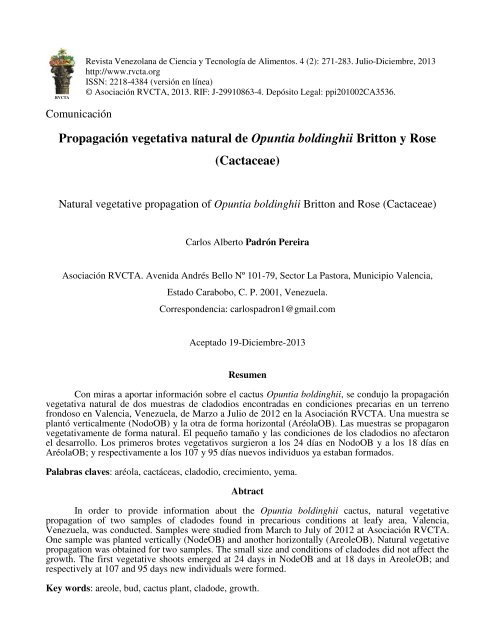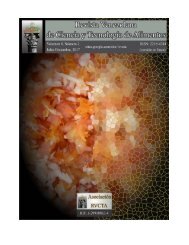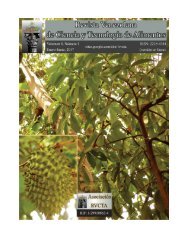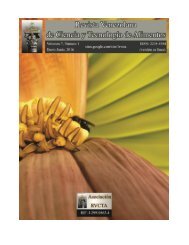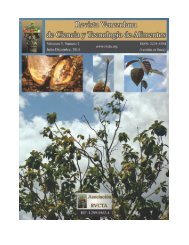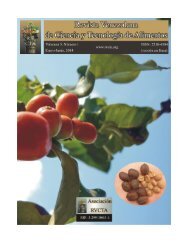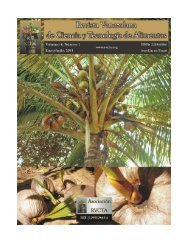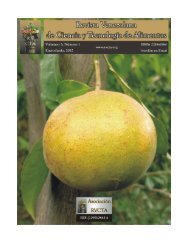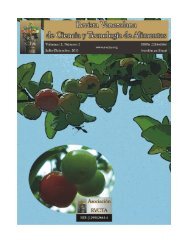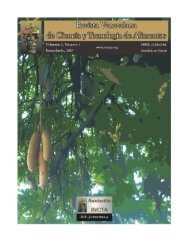Create successful ePaper yourself
Turn your PDF publications into a flip-book with our unique Google optimized e-Paper software.
<strong>RVCTA</strong><br />
Revista Venezolana de Ciencia y Tecnología de Alimentos. 4 (2): 271-283. Julio-Diciembre, 2013<br />
http://www.rvcta.org<br />
ISSN: 2218-4384 (versión en línea)<br />
© Asociación <strong>RVCTA</strong>, 2013. RIF: J-29910863-4. Depósito Legal: ppi201002CA3536.<br />
Comunicación<br />
Propagación vegetativa natural de Opuntia boldinghii Britton y Rose<br />
(Cactaceae)<br />
Natural vegetative propagation of Opuntia boldinghii Britton and Rose (Cactaceae)<br />
Carlos Alberto Padrón Pereira<br />
Asociación <strong>RVCTA</strong>. Avenida Andrés Bello Nº 101-79, Sector La Pastora, Municipio Valencia,<br />
Estado Carabobo, C. P. 2001, Venezuela.<br />
Correspondencia: carlospadron1@gmail.com<br />
Aceptado 19-Diciembre-2013<br />
Resumen<br />
Con miras a aportar información sobre el cactus Opuntia boldinghii, se condujo la propagación<br />
vegetativa natural de dos muestras de cladodios encontradas en condiciones precarias en un terreno<br />
frondoso en Valencia, Venezuela, de Marzo a Julio de 2012 en la Asociación <strong>RVCTA</strong>. Una muestra se<br />
plantó verticalmente (NodoOB) y la otra de forma horizontal (AréolaOB). Las muestras se propagaron<br />
vegetativamente de forma natural. El pequeño tamaño y las condiciones de los cladodios no afectaron<br />
el desarrollo. Los primeros brotes vegetativos surgieron a los 24 días en NodoOB y a los 18 días en<br />
AréolaOB; y respectivamente a los 107 y 95 días nuevos individuos ya estaban formados.<br />
Palabras claves: aréola, cactáceas, cladodio, crecimiento, yema.<br />
Abtract<br />
In order to provide information about the Opuntia boldinghii cactus, natural vegetative<br />
propagation of two samples of cladodes found in precarious conditions at leafy area, Valencia,<br />
Venezuela, was conducted. Samples were studied from March to July of 2012 at Asociación <strong>RVCTA</strong>.<br />
One sample was planted vertically (NodeOB) and another horizontally (AreoleOB). Natural vegetative<br />
propagation was obtained for two samples. The small size and conditions of cladodes did not affect the<br />
growth. The first vegetative shoots emerged at 24 days in NodeOB and at 18 days in AreoleOB; and<br />
respectively at 107 and 95 days new individuals were formed.<br />
Key words: areole, bud, cactus plant, cladode, growth.


